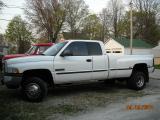- Replies 13
- Views 4.1k
- Created
- Last Reply
Top Posters In This Topic
-
 jumpjg 5 posts
jumpjg 5 posts -
 Mopar1973Man 2 posts
Mopar1973Man 2 posts -
 moostang 2 posts
moostang 2 posts -
 pepsi71ocean 1 post
pepsi71ocean 1 post


Shortly after purchasing my truck last November, I filled it up to get an understanding of how accurate the fuel gauge was. I found out it was somewhat conservative (~ 8 gal left when the light comes on @ the 1/8th tank level), and also found that the tank leaked fuel when full. Last Friday it had finally gotten warm enough & the tornadoes have subsided enough for me to drop the tank to find & fix the problem. The source of the problem was at the top of the fuel tank module. The lid of the module holds four components; the level sender electrical connector, the fuel suction/return lines, the roll-over valve, and an unused capped-off extra fuel line. Each one of these components is plug-shaped, about 1" in diameter, & is seald onto the lid with a rubber grommet. My problem was that the fuel suction/return line component had rusted through; not the lines themselves but rather the sheet metal that formed the plug & supported the lines.I called Mike to ask his advice on where to source a part (thanks Mike!) & he recommended I contact Vulcan, which I did. Their recommendation was the Draw Straw I, which is made to replace my rusted out part on the module lid; no drilling extra holes in the tank. I also ordered the big line kit & will be relocating my Airtex replacement pump down onto the frame rail next to the tank. The big line kit also includes elbows & hoses to replace the rigid line & banjos between the OEM filter & the injection pump. The injection pump elbow has a tap for a fuel pressure gauge to monitor pressure at the VP where it counts. I'm expecting delivery later this week.In the mean time I have plenty of work to do. After cleaning all the grime off the tank exterior with Purple Power & a scrub brush, I was able to do a pressure test of my tank to ensure that the filler & vent fittings were not leaking. Note: A Cool Whip container fits the module opening in the tank perfectly & allows the locking ring to screw down & seal off the big hole for a pressure test. My truck was originally owned & operated in up-state New York and it has seen it's fair share of salty roads - corrosion control is in order. I spent some time Saturday/Sunday adding doublers to the forward tank strap which had almost rusted through. And I have a new set of 1 3/16" bore rear wheel cylinders to install. I will update this thread with pictures as time permits.Joe in St Louis